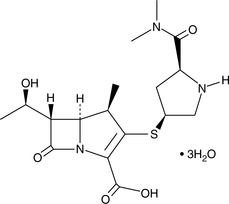Chemicals
Showing 26401–26550 of 41137 results
-
Menaquinone 9 (MK-9) is a vitamin K2 analog that has been found in various bacteria, including E. coli.{39966,29495} MK-9 is UV-sensitive and binds to soluble nitrate reductase, a component of the bacterial electron transport chain.{39966} In vivo, MK-9 increases plasma prothrombin concentration in vitamin K-deficient rats.{29495}
Brand:CaymanSKU:-Available on backorder
Mensacarcin is a bacterial metabolite that has been found in S. bottropensis and has anticancer activity.{57141,57140} It is cytostatic in the NCI-60 panel of cancer cell lines (mean IC50 = 1.3 µM) and cytotoxic to HepG2, HM02, KATO III, and MCF-7 cells (IC50s = 0.4-50 µM).{57141} Mensacarcin induces apoptosis in SK-MEL-28 and SK-MEL-5 melanoma cells.{57140}
Brand:CaymanSKU:31438 - 1 mgAvailable on backorder
Proteinase 3 (PR3, myeloblastin) is a polymorphonuclear leukocyte serine proteinase that degrades matrix proteins including fibronectin, laminin, vitronectin, and collagen type IV to generate antimicrobial peptides.{28835} Neutrophil elastase is a serine proteinase that is secreted by neutrophils during inflammation to destroy pathogens.{24588} Evaluating these enzymes is helpful to understanding inflammatory autoimmune processes. MeOSuc-AAPV-pNA is a highly sensitive peptide substrate that is hydrolyzed by both human and mouse neutrophil elastase and PR3, but not cathepsin G or chymotrypsin.{28836,28837} Enzyme activity can be quantified by colorimetric detection of free p-nitroanilide at 405 nm.
Brand:CaymanSKU:-Available on backorder
Proteinase 3 (PR3, myeloblastin) is a polymorphonuclear leukocyte serine proteinase that degrades matrix proteins including fibronectin, laminin, vitronectin, and collagen type IV to generate antimicrobial peptides.{28835} Neutrophil elastase is a serine proteinase that is secreted by neutrophils during inflammation to destroy pathogens.{24588} Evaluating these enzymes is helpful to understanding inflammatory autoimmune processes. MeOSuc-AAPV-pNA is a highly sensitive peptide substrate that is hydrolyzed by both human and mouse neutrophil elastase and PR3, but not cathepsin G or chymotrypsin.{28836,28837} Enzyme activity can be quantified by colorimetric detection of free p-nitroanilide at 405 nm.
Brand:CaymanSKU:-Available on backorder
Proteinase 3 (PR3, myeloblastin) is a polymorphonuclear leukocyte serine proteinase that degrades matrix proteins including fibronectin, laminin, vitronectin, and collagen type IV to generate antimicrobial peptides.{28835} Neutrophil elastase is a serine proteinase that is secreted by neutrophils during inflammation to destroy pathogens.{24588} Evaluating these enzymes is helpful to understanding inflammatory autoimmune processes. MeOSuc-AAPV-pNA is a highly sensitive peptide substrate that is hydrolyzed by both human and mouse neutrophil elastase and PR3, but not cathepsin G or chymotrypsin.{28836,28837} Enzyme activity can be quantified by colorimetric detection of free p-nitroanilide at 405 nm.
Brand:CaymanSKU:-Available on backorder
Proteinase 3 (PR3, myeloblastin) is a polymorphonuclear leukocyte serine proteinase that degrades matrix proteins including fibronectin, laminin, vitronectin, and collagen type IV to generate antimicrobial peptides.{28835} Neutrophil elastase is a serine proteinase that is secreted by neutrophils during inflammation to destroy pathogens.{24588} Evaluating these enzymes is helpful to understanding inflammatory autoimmune processes. MeOSuc-AAPV-pNA is a highly sensitive peptide substrate that is hydrolyzed by both human and mouse neutrophil elastase and PR3, but not cathepsin G or chymotrypsin.{28836,28837} Enzyme activity can be quantified by colorimetric detection of free p-nitroanilide at 405 nm.
Brand:CaymanSKU:-Available on backorder
MeOSuc-Ala-Ala-Pro-Val-AMC (MeOSuc-AAPV-AMC) is a fluorogenic substrate for human leukocyte and porcine pancreatic elastase. The methoxy succinyl (MeO-Suc) peptide AAPV is avidly hydrolyzed by these elastases but not by cathepsin G.{24237,23997} The addition of 7-amino-4-methylcoumarin (AMC) generates a peptide of low fluorescence (excitation: 355-380 nm; emission 440-460 nm) that demonstrates a linear increase in fluorescence in the presence of elastase.{24238} This peptidyl-AMC substrate detects as little as 11 pM human leukocyte elastase and 18 pM porcine pancreatic elastase.{24238}
Brand:CaymanSKU:-MeOSuc-Ala-Ala-Pro-Val-AMC (MeOSuc-AAPV-AMC) is a fluorogenic substrate for human leukocyte and porcine pancreatic elastase. The methoxy succinyl (MeO-Suc) peptide AAPV is avidly hydrolyzed by these elastases but not by cathepsin G.{24237,23997} The addition of 7-amino-4-methylcoumarin (AMC) generates a peptide of low fluorescence (excitation: 355-380 nm; emission 440-460 nm) that demonstrates a linear increase in fluorescence in the presence of elastase.{24238} This peptidyl-AMC substrate detects as little as 11 pM human leukocyte elastase and 18 pM porcine pancreatic elastase.{24238}
Brand:CaymanSKU:-MeOSuc-Ala-Ala-Pro-Val-AMC (MeOSuc-AAPV-AMC) is a fluorogenic substrate for human leukocyte and porcine pancreatic elastase. The methoxy succinyl (MeO-Suc) peptide AAPV is avidly hydrolyzed by these elastases but not by cathepsin G.{24237,23997} The addition of 7-amino-4-methylcoumarin (AMC) generates a peptide of low fluorescence (excitation: 355-380 nm; emission 440-460 nm) that demonstrates a linear increase in fluorescence in the presence of elastase.{24238} This peptidyl-AMC substrate detects as little as 11 pM human leukocyte elastase and 18 pM porcine pancreatic elastase.{24238}
Brand:CaymanSKU:-Mepenzolate is an antagonist of muscarinic (M) acetylcholine receptors (Kis = 0.68 and 2.6 nM for human M2 and M3 receptors, respectively).{41272} It has antispasmodic activity in the gastrointestinal tract of anesthetized cats and dogs when administered at a dose of 0.5 mg/kg.{41273} Mepenzolate decreases airspace enlargement induced by elastase or cigarette smoke and reduces respiratory dysfunction in a mouse model of chronic obstructive pulmonary disease (COPD).{41274} It also reduces oxidative stress, decreases the expression of IL-1β, IL-6, and TNF-α, and increases the expression of TGF-β1, IGF-1, and VEGF in a diabetic wound healing mouse model.{41275}
Brand:CaymanSKU:23717 - 1 gAvailable on backorder
Mepenzolate is an antagonist of muscarinic (M) acetylcholine receptors (Kis = 0.68 and 2.6 nM for human M2 and M3 receptors, respectively).{41272} It has antispasmodic activity in the gastrointestinal tract of anesthetized cats and dogs when administered at a dose of 0.5 mg/kg.{41273} Mepenzolate decreases airspace enlargement induced by elastase or cigarette smoke and reduces respiratory dysfunction in a mouse model of chronic obstructive pulmonary disease (COPD).{41274} It also reduces oxidative stress, decreases the expression of IL-1β, IL-6, and TNF-α, and increases the expression of TGF-β1, IGF-1, and VEGF in a diabetic wound healing mouse model.{41275}
Brand:CaymanSKU:23717 - 500 mgAvailable on backorder
Meperidine-d5 (hydrochloride) (exempt preparation) (Item No. 23788) is intended for use as an internal standard for the quantification of meperidine (Item No. 19406) by GC- or LC-MS. Meperidine is categorized as an opioid.{26976} It is an opioid analgesic that is commonly abused.{30201} Meperidine is regulated as a Schedule II compound in the United States. Meperidine-d5 (hydrochloride) (exempt preparation) (Item No. 23788) is provided as a DEA exempt preparation. This product is intended for research and forensic applications.
Brand:CaymanSKU:23788 - 1 mgAvailable on backorder
Mephedrone metabolite (hydrochloride) ((±)-ephedrine stereochemistry) (Item No. 14756) is an analytical reference standard categorized as a cathinone metabolite.{19963,19964} It is a metabolite of mephedrone (Item Nos. 10801 | 26277). This product is intended for research and forensic applications.
Brand:CaymanSKU:-Mephedrone metabolite (hydrochloride) ((±)-ephedrine stereochemistry) (Item No. 14756) is an analytical reference standard categorized as a cathinone metabolite.{19963,19964} It is a metabolite of mephedrone (Item Nos. 10801 | 26277). This product is intended for research and forensic applications.
Brand:CaymanSKU:-Mephedrone metabolite (hydrochloride) ((±)-ephedrine stereochemistry) (Item No. 14756) is an analytical reference standard categorized as a cathinone metabolite.{19963,19964} It is a metabolite of mephedrone (Item Nos. 10801 | 26277). This product is intended for research and forensic applications.
Brand:CaymanSKU:-Mepivacaine (Item No. 23402) is an analytical reference standard that is categorized as an anesthetic.{38355} This product is intended for research and forensic applications.
Brand:CaymanSKU:23402 - 1 mgAvailable on backorder
Mepivacaine (Item No. 23402) is an analytical reference standard that is categorized as an anesthetic.{38355} This product is intended for research and forensic applications.
Brand:CaymanSKU:23402 - 5 mgAvailable on backorder
Meprednisone is a corticosteroid.{59014} It is a methylated form of prednisone (Item No. 20677) and a metabolite of methylprednisolone (Item No. 15013).{59015,59014} Formulations containing meprednisone have been used in the treatment of drug-induced or seasonal allergies.
Brand:CaymanSKU:30289 - 100 mgAvailable on backorder
Meprednisone is a corticosteroid.{59014} It is a methylated form of prednisone (Item No. 20677) and a metabolite of methylprednisolone (Item No. 15013).{59015,59014} Formulations containing meprednisone have been used in the treatment of drug-induced or seasonal allergies.
Brand:CaymanSKU:30289 - 250 mgAvailable on backorder
Meprednisone is a corticosteroid.{59014} It is a methylated form of prednisone (Item No. 20677) and a metabolite of methylprednisolone (Item No. 15013).{59015,59014} Formulations containing meprednisone have been used in the treatment of drug-induced or seasonal allergies.
Brand:CaymanSKU:30289 - 50 mgAvailable on backorder
Meprednisone is a corticosteroid.{59014} It is a methylated form of prednisone (Item No. 20677) and a metabolite of methylprednisolone (Item No. 15013).{59015,59014} Formulations containing meprednisone have been used in the treatment of drug-induced or seasonal allergies.
Brand:CaymanSKU:30289 - 500 mgAvailable on backorder
Mepyramine is a first generation antihistamine that acts as an inverse agonist at the histamine H1 receptor. It is reported to bind with high affinity to a Gq/11 protein-coupled form of the receptor and to promote a G protein-coupled inactive state of the H1 receptor that interferes with the Gq/11-mediated signaling of the endogenously expressed receptor, as well as to reduce G protein availability for other non-related receptors associated with this signaling pathway.{32838} Mepyramine has been shown to inhibit histamine-induced inositol phosphate production with a log EC50 value of -7.94.{32838}
Brand:CaymanSKU:20978 -Out of stock
Mepyramine is a first generation antihistamine that acts as an inverse agonist at the histamine H1 receptor. It is reported to bind with high affinity to a Gq/11 protein-coupled form of the receptor and to promote a G protein-coupled inactive state of the H1 receptor that interferes with the Gq/11-mediated signaling of the endogenously expressed receptor, as well as to reduce G protein availability for other non-related receptors associated with this signaling pathway.{32838} Mepyramine has been shown to inhibit histamine-induced inositol phosphate production with a log EC50 value of -7.94.{32838}
Brand:CaymanSKU:20978 -Out of stock
Mepyramine is a first generation antihistamine that acts as an inverse agonist at the histamine H1 receptor. It is reported to bind with high affinity to a Gq/11 protein-coupled form of the receptor and to promote a G protein-coupled inactive state of the H1 receptor that interferes with the Gq/11-mediated signaling of the endogenously expressed receptor, as well as to reduce G protein availability for other non-related receptors associated with this signaling pathway.{32838} Mepyramine has been shown to inhibit histamine-induced inositol phosphate production with a log EC50 value of -7.94.{32838}
Brand:CaymanSKU:20978 -Out of stock
Mer-NF5003F is a sesquiterpene originally isolated from Stachybotrys with diverse biological activities.{46742,46743,46744} It inhibits avian myeloblastosis virus (AMV) protease (IC50 = 7.8 µM).{46742} Mer-NF5003F inhibits sialyltransferase 6N (ST6N), ST3O, and ST3N (IC50s = 0.61, 6.7, and 10 µg/ml, respectively), as well as fucosyltransferase (IC50 = 11.3 µg/ml).{46743} It is active against herpes simplex virus 1 (HSV-1) in vitro (IC50 = 4.32 µg/ml).{46744} Mer-NF5003F is also active against the multidrug-resistant P. falciparum strain K1 (IC50 = 0.85 µg/ml).
Brand:CaymanSKU:29961 - 1 mgAvailable on backorder
Mer-NF5003F is a sesquiterpene originally isolated from Stachybotrys with diverse biological activities.{46742,46743,46744} It inhibits avian myeloblastosis virus (AMV) protease (IC50 = 7.8 µM).{46742} Mer-NF5003F inhibits sialyltransferase 6N (ST6N), ST3O, and ST3N (IC50s = 0.61, 6.7, and 10 µg/ml, respectively), as well as fucosyltransferase (IC50 = 11.3 µg/ml).{46743} It is active against herpes simplex virus 1 (HSV-1) in vitro (IC50 = 4.32 µg/ml).{46744} Mer-NF5003F is also active against the multidrug-resistant P. falciparum strain K1 (IC50 = 0.85 µg/ml).
Brand:CaymanSKU:29961 - 5 mgAvailable on backorder
Merimepodib is an inhibitor of inosine-5′-monophosphate dehydrogenase (IMPDH; Kis = 7 and 10 nM for IMPDH type I and type II, respectively) with antiviral and immunosuppressant activities.{53250} It reduces Ebola, Lassa, chikungunya, Junin, and Zika virus titers in vitro and inhibits Zika virus replication in Huh7 cells (EC50 = 0.6 µM).{53251} Merimepodib inhibits the proliferation of PHA-stimulated T cells and SPAS-stimulated B cells (IC50s = 104 and 132 nM, respectively), effects that can be reversed by guanosine (Item No. 27702) but not adenosine (Item No. 21232).{53252} In vivo, merimepodib (50 and 100 mg/kg) increases allograft survival in a murine skin transplantation model and prevents development of graft versus host disease (GVHD) in splenocyte allografted mice.{53253}
Brand:CaymanSKU:29351 - 1 mgAvailable on backorder
Merimepodib is an inhibitor of inosine-5′-monophosphate dehydrogenase (IMPDH; Kis = 7 and 10 nM for IMPDH type I and type II, respectively) with antiviral and immunosuppressant activities.{53250} It reduces Ebola, Lassa, chikungunya, Junin, and Zika virus titers in vitro and inhibits Zika virus replication in Huh7 cells (EC50 = 0.6 µM).{53251} Merimepodib inhibits the proliferation of PHA-stimulated T cells and SPAS-stimulated B cells (IC50s = 104 and 132 nM, respectively), effects that can be reversed by guanosine (Item No. 27702) but not adenosine (Item No. 21232).{53252} In vivo, merimepodib (50 and 100 mg/kg) increases allograft survival in a murine skin transplantation model and prevents development of graft versus host disease (GVHD) in splenocyte allografted mice.{53253}
Brand:CaymanSKU:29351 - 10 mgAvailable on backorder
Merimepodib is an inhibitor of inosine-5′-monophosphate dehydrogenase (IMPDH; Kis = 7 and 10 nM for IMPDH type I and type II, respectively) with antiviral and immunosuppressant activities.{53250} It reduces Ebola, Lassa, chikungunya, Junin, and Zika virus titers in vitro and inhibits Zika virus replication in Huh7 cells (EC50 = 0.6 µM).{53251} Merimepodib inhibits the proliferation of PHA-stimulated T cells and SPAS-stimulated B cells (IC50s = 104 and 132 nM, respectively), effects that can be reversed by guanosine (Item No. 27702) but not adenosine (Item No. 21232).{53252} In vivo, merimepodib (50 and 100 mg/kg) increases allograft survival in a murine skin transplantation model and prevents development of graft versus host disease (GVHD) in splenocyte allografted mice.{53253}
Brand:CaymanSKU:29351 - 25 mgAvailable on backorder
Merimepodib is an inhibitor of inosine-5′-monophosphate dehydrogenase (IMPDH; Kis = 7 and 10 nM for IMPDH type I and type II, respectively) with antiviral and immunosuppressant activities.{53250} It reduces Ebola, Lassa, chikungunya, Junin, and Zika virus titers in vitro and inhibits Zika virus replication in Huh7 cells (EC50 = 0.6 µM).{53251} Merimepodib inhibits the proliferation of PHA-stimulated T cells and SPAS-stimulated B cells (IC50s = 104 and 132 nM, respectively), effects that can be reversed by guanosine (Item No. 27702) but not adenosine (Item No. 21232).{53252} In vivo, merimepodib (50 and 100 mg/kg) increases allograft survival in a murine skin transplantation model and prevents development of graft versus host disease (GVHD) in splenocyte allografted mice.{53253}
Brand:CaymanSKU:29351 - 5 mgAvailable on backorder
Meropenem is a carbapenem antibiotic.{26435} It is active against clinical isolates of Gram-positive and Gram-negative bacteria in vitro, including S. pneumoniae, H. influenzae, N. gonorrhoeae, E. coli, P. aeruginosa, C. difficile, and methicillin-susceptible and -resistant S. aureus (MICs = ≤0.008-8 μg/ml). It is protective against S. aureus, S. pneumoniae, E. coli, S. marcescens, P. mirabilis, and P. aeruginosa infections in mice with 50% protective dose (PD50) values of 0.13, 0.01, 0.04, 0.07, 0.84, and 0.46 mg/kg, respectively.{53193} Formulations containing meropenem have been used in the treatment of a variety of bacterial infections.
Brand:CaymanSKU:-Meropenem is a carbapenem antibiotic.{26435} It is active against clinical isolates of Gram-positive and Gram-negative bacteria in vitro, including S. pneumoniae, H. influenzae, N. gonorrhoeae, E. coli, P. aeruginosa, C. difficile, and methicillin-susceptible and -resistant S. aureus (MICs = ≤0.008-8 μg/ml). It is protective against S. aureus, S. pneumoniae, E. coli, S. marcescens, P. mirabilis, and P. aeruginosa infections in mice with 50% protective dose (PD50) values of 0.13, 0.01, 0.04, 0.07, 0.84, and 0.46 mg/kg, respectively.{53193} Formulations containing meropenem have been used in the treatment of a variety of bacterial infections.
Brand:CaymanSKU:-Meropenem is a carbapenem antibiotic.{26435} It is active against clinical isolates of Gram-positive and Gram-negative bacteria in vitro, including S. pneumoniae, H. influenzae, N. gonorrhoeae, E. coli, P. aeruginosa, C. difficile, and methicillin-susceptible and -resistant S. aureus (MICs = ≤0.008-8 μg/ml). It is protective against S. aureus, S. pneumoniae, E. coli, S. marcescens, P. mirabilis, and P. aeruginosa infections in mice with 50% protective dose (PD50) values of 0.13, 0.01, 0.04, 0.07, 0.84, and 0.46 mg/kg, respectively.{53193} Formulations containing meropenem have been used in the treatment of a variety of bacterial infections.
Brand:CaymanSKU:-Meropenem is a carbapenem antibiotic.{26435} It is active against clinical isolates of Gram-positive and Gram-negative bacteria in vitro, including S. pneumoniae, H. influenzae, N. gonorrhoeae, E. coli, P. aeruginosa, C. difficile, and methicillin-susceptible and -resistant S. aureus (MICs = ≤0.008-8 μg/ml). It is protective against S. aureus, S. pneumoniae, E. coli, S. marcescens, P. mirabilis, and P. aeruginosa infections in mice with 50% protective dose (PD50) values of 0.13, 0.01, 0.04, 0.07, 0.84, and 0.46 mg/kg, respectively.{53193} Formulations containing meropenem have been used in the treatment of a variety of bacterial infections.
Brand:CaymanSKU:-Meropenem-d6 is intended for use as an internal standard for the quantification of meropenem (Item No. 16068) by GC- or LC-MS. Meropenem is a carbapenem antibiotic.{26435} It is active against clinical isolates of Gram-positive and Gram-negative bacteria in vitro, including S. pneumoniae, H. influenzae, N. gonorrhoeae, E. coli, P. aeruginosa, C. difficile, and methicillin-susceptible and -resistant S. aureus (MICs = ≤0.008-8 μg/ml). It is protective against S. aureus, S. pneumoniae, E. coli, S. marcescens, P. mirabilis, and P. aeruginosa infections in mice with 50% protective dose (PD50) values of 0.13, 0.01, 0.04, 0.07, 0.84, and 0.46 mg/kg, respectively.{53193} Formulations containing meropenem have been used in the treatment of a variety of bacterial infections.
Brand:CaymanSKU:28616 - 1 mgAvailable on backorder
Mertansine is a thiol-containing derivative of maytansine that is cytotoxic to human epidermoid carcinoma KB and human breast cancer SK-BR-3 cells (IC50 = 1.10 nM for both).{35116} Formulations containing mertansine have been studied for the treatment of multiple myeloma and squamous cell carcinoma.{35114,35115}
Brand:CaymanSKU:22483 -Out of stock
Mertansine is a thiol-containing derivative of maytansine that is cytotoxic to human epidermoid carcinoma KB and human breast cancer SK-BR-3 cells (IC50 = 1.10 nM for both).{35116} Formulations containing mertansine have been studied for the treatment of multiple myeloma and squamous cell carcinoma.{35114,35115}
Brand:CaymanSKU:22483 -Out of stock
Mertansine is a thiol-containing derivative of maytansine that is cytotoxic to human epidermoid carcinoma KB and human breast cancer SK-BR-3 cells (IC50 = 1.10 nM for both).{35116} Formulations containing mertansine have been studied for the treatment of multiple myeloma and squamous cell carcinoma.{35114,35115}
Brand:CaymanSKU:22483 -Out of stock
Mescaline is a psychedelic phenethylamine that is found naturally in plants predominantly in the cactus family, including peyote (L. williamsii). It binds and activates serotonin receptors, with preference for 5-HT2A over 5-HT2C (EC50 = 4 and 24 μM, respectively).{21525} This product is intended for research and forensic purposes.
Brand:CaymanSKU:-Mesna is a cofactor found in methanogenic archaea that is essential for the final step of methanogenesis and is also important for alkene metabolism.{33384} It functions as an antioxidant and cytoprotective agent and is widely used for protection from toxicity of chemotherapeutic agents.{33385} In the bladder, mesna conjugates to urotoxic metabolites such as acrolein through a Michael addition, converting the toxic compound into inactive metabolites that can be excreted in the urine.{33385}
Brand:CaymanSKU:21238 -Out of stock
Mesna is a cofactor found in methanogenic archaea that is essential for the final step of methanogenesis and is also important for alkene metabolism.{33384} It functions as an antioxidant and cytoprotective agent and is widely used for protection from toxicity of chemotherapeutic agents.{33385} In the bladder, mesna conjugates to urotoxic metabolites such as acrolein through a Michael addition, converting the toxic compound into inactive metabolites that can be excreted in the urine.{33385}
Brand:CaymanSKU:21238 -Out of stock
meso-2,3-Dimercaptosuccinic acid is a heavy metal chelator.{45474} It reverses sodium arsenite-induced inhibition of pyruvate dehydrogenase (PDH) in mouse kidney homogenates (EC50 = 0.25 mM). meso-2,3-Dimercaptosuccinic acid decreases cisplatin-induced increases in serum levels of platinum and blood urea nitrogen (BUN), as well as apoptosis in renal tubules of mice when administered at a dose of 100 µM/kg.{45475} meso-2,3-Dimercaptosuccinic acid (90 mg/kg) decreases elevations in the activity of catalase and glucose-6-phosphate dehydrogenase (G6PDH) in RBCs from lead-exposed rats, and decreases the levels of lead in the cerebellum, hippocampus, liver, kidney, and blood in rats when administered at a dose of 100 mg/kg.{45476,45477} It decreases immobility time in the forced swim test in lead-exposed male, but not female, mice when administered at a dose of 50 mg/kg.{45478} Formulations containing meso-2,3-dimercaptosuccinic acid have been used in the treatment of heavy metal poisoning.
Brand:CaymanSKU:28515 - 1 gAvailable on backorder
meso-2,3-Dimercaptosuccinic acid is a heavy metal chelator.{45474} It reverses sodium arsenite-induced inhibition of pyruvate dehydrogenase (PDH) in mouse kidney homogenates (EC50 = 0.25 mM). meso-2,3-Dimercaptosuccinic acid decreases cisplatin-induced increases in serum levels of platinum and blood urea nitrogen (BUN), as well as apoptosis in renal tubules of mice when administered at a dose of 100 µM/kg.{45475} meso-2,3-Dimercaptosuccinic acid (90 mg/kg) decreases elevations in the activity of catalase and glucose-6-phosphate dehydrogenase (G6PDH) in RBCs from lead-exposed rats, and decreases the levels of lead in the cerebellum, hippocampus, liver, kidney, and blood in rats when administered at a dose of 100 mg/kg.{45476,45477} It decreases immobility time in the forced swim test in lead-exposed male, but not female, mice when administered at a dose of 50 mg/kg.{45478} Formulations containing meso-2,3-dimercaptosuccinic acid have been used in the treatment of heavy metal poisoning.
Brand:CaymanSKU:28515 - 10 gAvailable on backorder
meso-2,3-Dimercaptosuccinic acid is a heavy metal chelator.{45474} It reverses sodium arsenite-induced inhibition of pyruvate dehydrogenase (PDH) in mouse kidney homogenates (EC50 = 0.25 mM). meso-2,3-Dimercaptosuccinic acid decreases cisplatin-induced increases in serum levels of platinum and blood urea nitrogen (BUN), as well as apoptosis in renal tubules of mice when administered at a dose of 100 µM/kg.{45475} meso-2,3-Dimercaptosuccinic acid (90 mg/kg) decreases elevations in the activity of catalase and glucose-6-phosphate dehydrogenase (G6PDH) in RBCs from lead-exposed rats, and decreases the levels of lead in the cerebellum, hippocampus, liver, kidney, and blood in rats when administered at a dose of 100 mg/kg.{45476,45477} It decreases immobility time in the forced swim test in lead-exposed male, but not female, mice when administered at a dose of 50 mg/kg.{45478} Formulations containing meso-2,3-dimercaptosuccinic acid have been used in the treatment of heavy metal poisoning.
Brand:CaymanSKU:28515 - 5 gAvailable on backorder
Mesoridazine is an active metabolite of the typical antipsychotic thioridazine (Item No. 14400).{56193,56195} It is formed via sulfoxidation of thioridazine by the cytochrome P450 (CYP) isoform CYP2D6 in human liver microsomes.{56194} It binds to histamine H1, dopamine D2, muscarinic acetylcholine, and α1- and α2-adrenergic receptors (Kds = 1.8, 19, 69, 2, and 1,600 nM, respectively).{56195} Mesoridazine (10, 30, and 45 mg/kg, i.p.) prevents mescaline-induced hyperactivity in mice.{56196}
Brand:CaymanSKU:31370 - 10 mgAvailable on backorder
Mesoridazine is an active metabolite of the typical antipsychotic thioridazine (Item No. 14400).{56193,56195} It is formed via sulfoxidation of thioridazine by the cytochrome P450 (CYP) isoform CYP2D6 in human liver microsomes.{56194} It binds to histamine H1, dopamine D2, muscarinic acetylcholine, and α1- and α2-adrenergic receptors (Kds = 1.8, 19, 69, 2, and 1,600 nM, respectively).{56195} Mesoridazine (10, 30, and 45 mg/kg, i.p.) prevents mescaline-induced hyperactivity in mice.{56196}
Brand:CaymanSKU:31370 - 100 mgAvailable on backorder
Mesoridazine is an active metabolite of the typical antipsychotic thioridazine (Item No. 14400).{56193,56195} It is formed via sulfoxidation of thioridazine by the cytochrome P450 (CYP) isoform CYP2D6 in human liver microsomes.{56194} It binds to histamine H1, dopamine D2, muscarinic acetylcholine, and α1- and α2-adrenergic receptors (Kds = 1.8, 19, 69, 2, and 1,600 nM, respectively).{56195} Mesoridazine (10, 30, and 45 mg/kg, i.p.) prevents mescaline-induced hyperactivity in mice.{56196}
Brand:CaymanSKU:31370 - 25 mgAvailable on backorder
Mesoridazine is an active metabolite of the typical antipsychotic thioridazine (Item No. 14400).{56193,56195} It is formed via sulfoxidation of thioridazine by the cytochrome P450 (CYP) isoform CYP2D6 in human liver microsomes.{56194} It binds to histamine H1, dopamine D2, muscarinic acetylcholine, and α1- and α2-adrenergic receptors (Kds = 1.8, 19, 69, 2, and 1,600 nM, respectively).{56195} Mesoridazine (10, 30, and 45 mg/kg, i.p.) prevents mescaline-induced hyperactivity in mice.{56196}
Brand:CaymanSKU:31370 - 50 mgAvailable on backorder
Mestranol is a semi-synthetic estrogen prodrug of ethynyl estradiol (Item No. 10006486), an estrogen receptor agonist.{41236} It is demethylated in the liver to ethynyl estradiol. Mestranol has estrogenic properties, inducing RNA synthesis in homogenized mouse uteri following a dose of 1.6 µg/animal, which is 16-fold higher than the dose of ethynyl estradiol needed to induce a similar response.{41237} Formulations containing mestranol were previously used as oral contraceptives.
Brand:CaymanSKU:23822 - 10 mgAvailable on backorder
Mestranol is a semi-synthetic estrogen prodrug of ethynyl estradiol (Item No. 10006486), an estrogen receptor agonist.{41236} It is demethylated in the liver to ethynyl estradiol. Mestranol has estrogenic properties, inducing RNA synthesis in homogenized mouse uteri following a dose of 1.6 µg/animal, which is 16-fold higher than the dose of ethynyl estradiol needed to induce a similar response.{41237} Formulations containing mestranol were previously used as oral contraceptives.
Brand:CaymanSKU:23822 - 100 mgAvailable on backorder
Mestranol is a semi-synthetic estrogen prodrug of ethynyl estradiol (Item No. 10006486), an estrogen receptor agonist.{41236} It is demethylated in the liver to ethynyl estradiol. Mestranol has estrogenic properties, inducing RNA synthesis in homogenized mouse uteri following a dose of 1.6 µg/animal, which is 16-fold higher than the dose of ethynyl estradiol needed to induce a similar response.{41237} Formulations containing mestranol were previously used as oral contraceptives.
Brand:CaymanSKU:23822 - 50 mgAvailable on backorder
meta-fluoro 4-ANBP (Item No. 25959) is an analytical reference standard that is structurally similar to known opioids. It is a potential impurity in the synthesis of N-benzyl meta-fluoro norfentanyl (Item No. 25541). This product is intended for research and forensic applications.
Brand:CaymanSKU:25959 - 1 mgAvailable on backorder
meta-fluoro 4-ANBP (Item No. 25959) is an analytical reference standard that is structurally similar to known opioids. It is a potential impurity in the synthesis of N-benzyl meta-fluoro norfentanyl (Item No. 25541). This product is intended for research and forensic applications.
Brand:CaymanSKU:25959 - 5 mgAvailable on backorder
meta-Fluoxetine is an isomer of fluoxetine (Item No. 14418) that is found as an impurity in fluoxetine preparations. meta-Fluoxetine is a weaker serotonin selective reuptake inhibitor (SSRI) than fluoxetine, in which the trifluoromethyl group is at the para position (Kis = 166 and 17 nM, respectively, in rat brain synaptosomes).{36026,36027}
Brand:CaymanSKU:22158 -Out of stock
meta-Fluoxetine is an isomer of fluoxetine (Item No. 14418) that is found as an impurity in fluoxetine preparations. meta-Fluoxetine is a weaker serotonin selective reuptake inhibitor (SSRI) than fluoxetine, in which the trifluoromethyl group is at the para position (Kis = 166 and 17 nM, respectively, in rat brain synaptosomes).{36026,36027}
Brand:CaymanSKU:22158 -Out of stock
meta-Fluoxetine is an isomer of fluoxetine (Item No. 14418) that is found as an impurity in fluoxetine preparations. meta-Fluoxetine is a weaker serotonin selective reuptake inhibitor (SSRI) than fluoxetine, in which the trifluoromethyl group is at the para position (Kis = 166 and 17 nM, respectively, in rat brain synaptosomes).{36026,36027}
Brand:CaymanSKU:22158 -Out of stock
Metaescaline (hydrochloride) (Item No. 19927) is an analytical reference standard that is structurally classified as a phenethylamine. It is a derivative of escaline (Item No. 14107) in which the single ethyl group is reoriented to the meta position.{31967} This product is intended for research and forensic purposes.
Brand:CaymanSKU:19927 -Available on backorder
Metaescaline (hydrochloride) (Item No. 19927) is an analytical reference standard that is structurally classified as a phenethylamine. It is a derivative of escaline (Item No. 14107) in which the single ethyl group is reoriented to the meta position.{31967} This product is intended for research and forensic purposes.
Brand:CaymanSKU:19927 -Available on backorder
Metalaxyl is a fungicide that inhibits protein synthesis in fungi.{43133,42434} It inhibits the growth of potato blight (P. infestans) fungal isolates from Serbian potato fields (EC50s = 0.3-3.9 μg/ml).{43133} Metalaxyl (300 and 1,000 μg/ml) induces formation of chromosomal aberrations in human lymphocytes.{42433} It exhibits aquatic toxicity against S. quadricanda, D. magna, and D. rerio (IC50s = 222.89, 471.95, and 241.98 mg/L, respectively).{42435} Metalaxyl also induces tremors, twitches, tonic extension, ataxia, and hypnosis, symptoms of CNS poisoning, and lethality in rats (LD50s = 265 and 288.8 mg/kg for female and male rats, respectively).{42434}
Brand:CaymanSKU:25817 - 100 mgAvailable on backorder
Metalaxyl is a fungicide that inhibits protein synthesis in fungi.{43133,42434} It inhibits the growth of potato blight (P. infestans) fungal isolates from Serbian potato fields (EC50s = 0.3-3.9 μg/ml).{43133} Metalaxyl (300 and 1,000 μg/ml) induces formation of chromosomal aberrations in human lymphocytes.{42433} It exhibits aquatic toxicity against S. quadricanda, D. magna, and D. rerio (IC50s = 222.89, 471.95, and 241.98 mg/L, respectively).{42435} Metalaxyl also induces tremors, twitches, tonic extension, ataxia, and hypnosis, symptoms of CNS poisoning, and lethality in rats (LD50s = 265 and 288.8 mg/kg for female and male rats, respectively).{42434}
Brand:CaymanSKU:25817 - 50 mgAvailable on backorder
Metamizole is a nonopioid prodrug that is rapidly hydrolyzed to the analgesic and antipyretic metabolites 4-methylaminoantipyrine (MAA) and 4-aminoantipyrine (AA).{25749} It inhibits COX-1 and COX-2 activity (IC50 = ~150 µg/ml for both in cell-free assays), as well as reduces increases in intracellular calcium levels induced by the TRPA1 agonist AITC in isolated rat and mouse dorsal root ganglia and IMR-90 human fibroblasts (IC50s = 30-91 µM in patch-clamp assays).{46639,46640} Metamizole (6, 12, and 25 µg/ml) inhibits ADP- and epinephrine-induced platelet aggregation in human platelet-rich plasma (hPRP).{46641} It prevents fever induced by LPS, TNF-α, and IL-6, but not arachidonic acid (Item Nos. 90010 | 90010.1 | 10006607) or prostaglandin E2 (PGE2; Item No. 14010), in rats when administered at a dose of 120 mg/kg.{46642} Metamizole (250 and 500 mg/kg) increases the paw withdrawal threshold in the paw pressure test, indicating analgesic activity, in rat models of carrageenan-induced acute pain and postoperative incision pain.{46643}
Brand:CaymanSKU:-Metamizole is a nonopioid prodrug that is rapidly hydrolyzed to the analgesic and antipyretic metabolites 4-methylaminoantipyrine (MAA) and 4-aminoantipyrine (AA).{25749} It inhibits COX-1 and COX-2 activity (IC50 = ~150 µg/ml for both in cell-free assays), as well as reduces increases in intracellular calcium levels induced by the TRPA1 agonist AITC in isolated rat and mouse dorsal root ganglia and IMR-90 human fibroblasts (IC50s = 30-91 µM in patch-clamp assays).{46639,46640} Metamizole (6, 12, and 25 µg/ml) inhibits ADP- and epinephrine-induced platelet aggregation in human platelet-rich plasma (hPRP).{46641} It prevents fever induced by LPS, TNF-α, and IL-6, but not arachidonic acid (Item Nos. 90010 | 90010.1 | 10006607) or prostaglandin E2 (PGE2; Item No. 14010), in rats when administered at a dose of 120 mg/kg.{46642} Metamizole (250 and 500 mg/kg) increases the paw withdrawal threshold in the paw pressure test, indicating analgesic activity, in rat models of carrageenan-induced acute pain and postoperative incision pain.{46643}
Brand:CaymanSKU:-Metanephrine is a metabolite of epinephrine produced by the action of catechol-O-methyl transferase on epinephrine.{25427} Determination of plasma or urinary metanephrine is considered the principal test for the clinical diagnosis of pheochromocytoma, an adrenal medullary neuroendocrine tumor.{5331}
Brand:CaymanSKU:-Metanephrine is a metabolite of epinephrine produced by the action of catechol-O-methyl transferase on epinephrine.{25427} Determination of plasma or urinary metanephrine is considered the principal test for the clinical diagnosis of pheochromocytoma, an adrenal medullary neuroendocrine tumor.{5331}
Brand:CaymanSKU:-Metanephrine is a metabolite of epinephrine produced by the action of catechol-O-methyl transferase on epinephrine.{25427} Determination of plasma or urinary metanephrine is considered the principal test for the clinical diagnosis of pheochromocytoma, an adrenal medullary neuroendocrine tumor.{5331}
Brand:CaymanSKU:-Metaproterenol is a β2-adrenergic receptor (β2-AR) agonist with bronchodilator actions.{40372} It inhibits TGF-α-induced hepatocyte DNA synthesis and proliferation in vitro (IC50 = 15 nM), an effect that is reversed by the β2-AR antagonist butoxamine but not the β1-AR antagonist metoprolol (Item No. 15429).{40371} Metaproterenol dose-dependently relaxes lung strips and increases heart rate and inotropy of right atria and left atria, respectively, isolated from guinea pig (pD2s = 6.4, 7.08, and 6.61, respectively).{40373} Formulations containing metaproterenol were previously used as long-acting bronchodilators for the treatment of asthma.
Brand:CaymanSKU:23611 - 100 mgAvailable on backorder
Metaproterenol is a β2-adrenergic receptor (β2-AR) agonist with bronchodilator actions.{40372} It inhibits TGF-α-induced hepatocyte DNA synthesis and proliferation in vitro (IC50 = 15 nM), an effect that is reversed by the β2-AR antagonist butoxamine but not the β1-AR antagonist metoprolol (Item No. 15429).{40371} Metaproterenol dose-dependently relaxes lung strips and increases heart rate and inotropy of right atria and left atria, respectively, isolated from guinea pig (pD2s = 6.4, 7.08, and 6.61, respectively).{40373} Formulations containing metaproterenol were previously used as long-acting bronchodilators for the treatment of asthma.
Brand:CaymanSKU:23611 - 25 mgAvailable on backorder
Metaproterenol is a β2-adrenergic receptor (β2-AR) agonist with bronchodilator actions.{40372} It inhibits TGF-α-induced hepatocyte DNA synthesis and proliferation in vitro (IC50 = 15 nM), an effect that is reversed by the β2-AR antagonist butoxamine but not the β1-AR antagonist metoprolol (Item No. 15429).{40371} Metaproterenol dose-dependently relaxes lung strips and increases heart rate and inotropy of right atria and left atria, respectively, isolated from guinea pig (pD2s = 6.4, 7.08, and 6.61, respectively).{40373} Formulations containing metaproterenol were previously used as long-acting bronchodilators for the treatment of asthma.
Brand:CaymanSKU:23611 - 50 mgAvailable on backorder
Metaraminol is a vasoconstrictor.{36334,36335} In vivo, metaraminol (0.05 mg/kg) increases cardiac output, mean arterial pressure, and coronary blood flow and decreases pulse rate in a canine model of cardiogenic shock.{36334} It increases survival in a canine model of hemorrhagic hypotension.{36335} Metaraminol also reverses acetoxycycloheximide-induced transient amnesia in a shock avoidance test in rats.{36336}
Brand:CaymanSKU:23938 - 100 mgAvailable on backorder
Metaraminol is a vasoconstrictor.{36334,36335} In vivo, metaraminol (0.05 mg/kg) increases cardiac output, mean arterial pressure, and coronary blood flow and decreases pulse rate in a canine model of cardiogenic shock.{36334} It increases survival in a canine model of hemorrhagic hypotension.{36335} Metaraminol also reverses acetoxycycloheximide-induced transient amnesia in a shock avoidance test in rats.{36336}
Brand:CaymanSKU:23938 - 50 mgAvailable on backorder
Metastin (45-54) is a 10 amino acid peptide that corresponds to the bioactive C-terminal 45-54 amino acids of metastin, a metastasis suppressor gene product.{32826} It acts as a potent agonist of GPR54 (OT7T175, AXOR12), with approximately 8-fold higher binding affinity than metastin (Ki values of 0.042 and 0.34 nM, respectively, for displacement of metastin (40-54)).{32826} Metastin (45-54) induces calcium mobilization in GPR54-transfected cells (EC50 = 0.18-1.1 nM).{32827} It inhibits the migration of GPR54-transfected CHO cells at concentrations of 10-100 nM, equaling the potency of full length metastin.{32825}
Brand:CaymanSKU:20905 -Out of stock
Metastin (45-54) is a 10 amino acid peptide that corresponds to the bioactive C-terminal 45-54 amino acids of metastin, a metastasis suppressor gene product.{32826} It acts as a potent agonist of GPR54 (OT7T175, AXOR12), with approximately 8-fold higher binding affinity than metastin (Ki values of 0.042 and 0.34 nM, respectively, for displacement of metastin (40-54)).{32826} Metastin (45-54) induces calcium mobilization in GPR54-transfected cells (EC50 = 0.18-1.1 nM).{32827} It inhibits the migration of GPR54-transfected CHO cells at concentrations of 10-100 nM, equaling the potency of full length metastin.{32825}
Brand:CaymanSKU:20905 -Out of stock
Metastin (45-54) is a 10 amino acid peptide that corresponds to the bioactive C-terminal 45-54 amino acids of metastin, a metastasis suppressor gene product.{32826} It acts as a potent agonist of GPR54 (OT7T175, AXOR12), with approximately 8-fold higher binding affinity than metastin (Ki values of 0.042 and 0.34 nM, respectively, for displacement of metastin (40-54)).{32826} Metastin (45-54) induces calcium mobilization in GPR54-transfected cells (EC50 = 0.18-1.1 nM).{32827} It inhibits the migration of GPR54-transfected CHO cells at concentrations of 10-100 nM, equaling the potency of full length metastin.{32825}
Brand:CaymanSKU:20905 -Out of stock
Metaxalone is a skeletal muscle relaxant that has applications in reducing muscle spasm, limitations in normal motion, and pain caused by musculoskeletal conditions.{25863,25864,25861} It is commonly used in combination with analgesics to address low back pain.{25862} The molecular or cellular actions of metaxalone is not known.{25863,25862}
Brand:CaymanSKU:-Metaxalone is a skeletal muscle relaxant that has applications in reducing muscle spasm, limitations in normal motion, and pain caused by musculoskeletal conditions.{25863,25864,25861} It is commonly used in combination with analgesics to address low back pain.{25862} The molecular or cellular actions of metaxalone is not known.{25863,25862}
Brand:CaymanSKU:-Metaxalone is a skeletal muscle relaxant that has applications in reducing muscle spasm, limitations in normal motion, and pain caused by musculoskeletal conditions.{25863,25864,25861} It is commonly used in combination with analgesics to address low back pain.{25862} The molecular or cellular actions of metaxalone is not known.{25863,25862}
Brand:CaymanSKU:-Metaxalone is a skeletal muscle relaxant that has applications in reducing muscle spasm, limitations in normal motion, and pain caused by musculoskeletal conditions.{25863,25864,25861} It is commonly used in combination with analgesics to address low back pain.{25862} The molecular or cellular actions of metaxalone is not known.{25863,25862}
Brand:CaymanSKU:-Metergoline is a serotonin (5-HT) receptor antagonist that is active at 5-HT1 (pKi = 7.8 for 5-HT1B), 5-HT2, (pKi = 8.64, 8.75, and 8.75 for 5-HT2A, 5-HT2B, and 5-HT2C respectively), and 5-HT7 receptor subtypes.{41065,41063} It blocks 5-HT7 receptor-stimulated cAMP production (IC50 = 321 nM) in HEK293 cells.{34420} Metergoline has been widely used to study serotonin receptor function, but it also dose-dependently inhibits voltage-dependent sodium and potassium channels transfected into Xenopus oocytes.{34421,41064} Formulations containing metergoline have been studied for the treatment of hormone dysfunction, seasonal affective disorder, and anxiety.{34421}
Brand:CaymanSKU:21336 -Out of stock
Metergoline is a serotonin (5-HT) receptor antagonist that is active at 5-HT1 (pKi = 7.8 for 5-HT1B), 5-HT2, (pKi = 8.64, 8.75, and 8.75 for 5-HT2A, 5-HT2B, and 5-HT2C respectively), and 5-HT7 receptor subtypes.{41065,41063} It blocks 5-HT7 receptor-stimulated cAMP production (IC50 = 321 nM) in HEK293 cells.{34420} Metergoline has been widely used to study serotonin receptor function, but it also dose-dependently inhibits voltage-dependent sodium and potassium channels transfected into Xenopus oocytes.{34421,41064} Formulations containing metergoline have been studied for the treatment of hormone dysfunction, seasonal affective disorder, and anxiety.{34421}
Brand:CaymanSKU:21336 -Out of stock
Metergoline is a serotonin (5-HT) receptor antagonist that is active at 5-HT1 (pKi = 7.8 for 5-HT1B), 5-HT2, (pKi = 8.64, 8.75, and 8.75 for 5-HT2A, 5-HT2B, and 5-HT2C respectively), and 5-HT7 receptor subtypes.{41065,41063} It blocks 5-HT7 receptor-stimulated cAMP production (IC50 = 321 nM) in HEK293 cells.{34420} Metergoline has been widely used to study serotonin receptor function, but it also dose-dependently inhibits voltage-dependent sodium and potassium channels transfected into Xenopus oocytes.{34421,41064} Formulations containing metergoline have been studied for the treatment of hormone dysfunction, seasonal affective disorder, and anxiety.{34421}
Brand:CaymanSKU:21336 -Out of stock
Metergoline is a serotonin (5-HT) receptor antagonist that is active at 5-HT1 (pKi = 7.8 for 5-HT1B), 5-HT2, (pKi = 8.64, 8.75, and 8.75 for 5-HT2A, 5-HT2B, and 5-HT2C respectively), and 5-HT7 receptor subtypes.{41065,41063} It blocks 5-HT7 receptor-stimulated cAMP production (IC50 = 321 nM) in HEK293 cells.{34420} Metergoline has been widely used to study serotonin receptor function, but it also dose-dependently inhibits voltage-dependent sodium and potassium channels transfected into Xenopus oocytes.{34421,41064} Formulations containing metergoline have been studied for the treatment of hormone dysfunction, seasonal affective disorder, and anxiety.{34421}
Brand:CaymanSKU:21336 -Out of stock






























